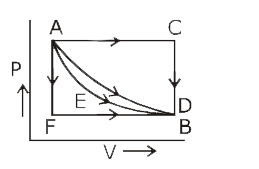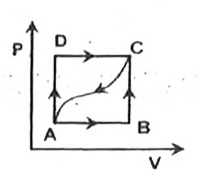
50 cal of heat should be supplied to take a system from the state A to the state B through the path ACB as shown in Figure. The quantity of heat to be supplied to take it from A to B via ADB.
process ACB:
ΔACB=ΔWAC+ΔWCB
=50×103×(400−200)×10−6+0
=10J=104.2=2.4cal
ΔQ=50cal
ΔQ=ΔU+ΔW=UB−UA+ΔW
50=(UB−UA)+2.4
UB−UA=47.6cal
Process ADB:
ΔWADB=ΔWAD+ΔWDB
=0+155×103×(400−200)×10−6
=31J=314.2=7.4cal
ΔQ=ΔU+ΔW=UB−UA+7.4
=47.6+7.4
=55cal
Topper's Solved these Questions
Similar Questions
50 eal of heat should be supplied to take a system from the state A to the state B through the path ABC as shown in ,find the quantity of heat to be supplied to take it from A to B via ADB.

View SolutionAn ideal system can be brought from stage A to B through four paths as shown in the figure. The heat energy given to the system is minimum in :

View Solution
Knowledge Check
An ideal system can be brought from stage A to B through Four paths as shown in the figure. The energy given to the system is minimum is:
 Apath ACBBpath ADBCpath AEBDpath AFB
Apath ACBBpath ADBCpath AEBDpath AFBAn ideal gas undergoes change in its state from the initial state I to the final state F via two possible paths as shown. Then
 Athere is no change in internal energy along path 1Bheat is not absorbed by the gas in both pathsCthe temperature of the gas first increases and then decreases for path 2Dwork done by the gas is larger in path 1.
Athere is no change in internal energy along path 1Bheat is not absorbed by the gas in both pathsCthe temperature of the gas first increases and then decreases for path 2Dwork done by the gas is larger in path 1.A thermodynamic process undergoes a cyclic process ABCDEBFGA as shown in the figure. Find the quantity of heat supplied to the system over one complete cycle.
 Aπ4B3π2C2πD5π2
Aπ4B3π2C2πD5π2
The given figure shown a change of state A to state C by two paths ABC and AC for an ideal gas. Calculate the :

(a) Path along which work done is least.
(b) Internal energy at C if the internal energy of gas at A is 10J and amount of heat supplied to change its state to C through the path AC is 200J.
(c) Amount of heat supplied ot the gas to go from A to B, if internal energy of gas at state B is 10J.
View SolutionHow much heat flows into the system along path ADB it the work done by the system is 10 J?
When a system is taken from state A to state B along the parth ACB in the figure below ,80 j of heat flows into the system and the system does 30 J of work.

View SolutionWhen the system is retuned form state B to A along the curved path, the work doen on the system is 20 J Does the system absorb ro liberate heat, and how much?
When a system is taken from state A to state B along the parth ACB in the figure below ,80 j of heat flows into the system and the system does 30 J of work.
View SolutionIn the adjoinign P-V diagram, 100 J of heat is given in taking a system from A to C along the path ADC and 50 J of work is done by system in this path.
a. If the work done by the suystem is 15 J along the path ABC, then how much heat is to be given in taking the system from A to C along ABC?

b. How much heat will be absorbed or given out if the work done on the system along the curved path from CA to A is 15 J?
c. If UB−UA=40J, then how much heat will be absorbed in each process AB and BC?
View SolutionOne mole of an ideal monoatomic gas is taken through the thermodynamic process shown in the P−V diagram. The heat supplied to the system is

View Solution
